Harris C.M., Piersol A.G. Harris Shock and vibration handbook
Подождите немного. Документ загружается.

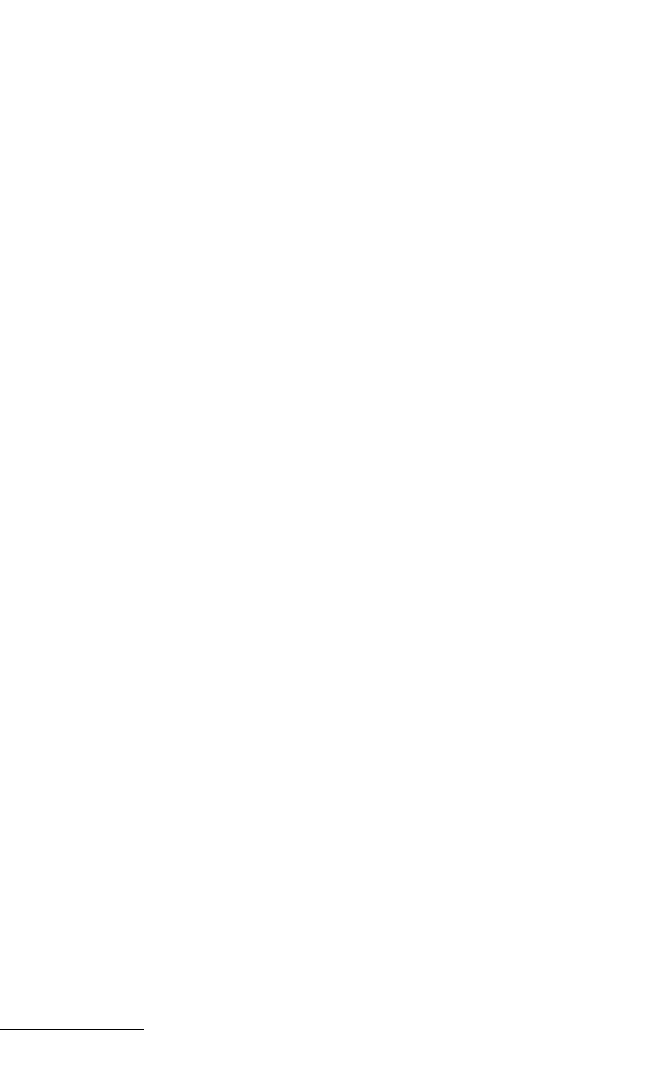
observed. Another approach is to short-circuit the signal path at various points in
the system (where this is practical), one at a time, until the system electrical noise
disappears. Usually this pinpoints the source as the component next nearest the
transducer from the last short circuit.
Spurious mechanical sources and acoustic noise sources must be eliminated or
controlled if they result in noise in the measurement system. Spurious resonances in
the response of the overall system may result from improper seating of the trans-
ducer on the test surface or from resonances in the transducer mounting. It is often
very useful to excite the transducer-mounting system by giving it a blow and then to
observe the transducer’s output—look for resonances other than the resonance fre-
quency of the transducer.The other resonance frequencies which appear may be due
to (1) resonances in the test specimen or (2) resonances in the transducer mounting.
Loose mountings usually produce “noisy” signals and may produce audible buzzing
sounds. Often it is difficult to determine the difference between resonances in the
mounting and resonances in the item under test. If serious doubt exists, the test
should be repeated with a different mounting or a different measurement location
for the transducer. If the resonance frequencies are identical for the new mounting,
the resonances are probably due to the test specimen, and the original mounting
probably was satisfactory.
Combining Calibration Characteristics of a Measurement System’s Compo-
nents. An overall system can be calibrated by combining the measured electrical
characteristics of all components in the measurement system from one end to the
other. Obtaining a system calibration in this way circumvents the difficulties of pre-
cise field calibration, but it requires that each element in the system be calibrated in
the laboratory with extreme care and that the effects of the source and load imped-
ances be completely accounted for. Thus, a system calibration is subject to the sum
of the experimental errors introduced by the calibration of each element, in addition
to any errors resulting from improper simulation of, or accounting for, loading
effects. In general, the calibration of each element is performed before the
system is assembled, and so this method is subject to error resulting from (1) unde-
tected damage to components between calibration and use and/or (2) improper con-
nections, misidentifications, or confusion in polarity.
Voltage Substitution Method of Calibration. A suitable simulated transducer
for use in field checkout must duplicate the electrical outputs of the actual trans-
ducer for the various vibration conditions to be simulated.The simulated transducer
must either (1) reproduce the electrical voltage- or current-generating characteris-
tics of the actual transducer and have the same output impedance or (2) duplicate
the electrical quantity generated by the actual transducer when connected to its
load. Failure to meet these conditions will result in a different loading of the actual
and simulated transducers and will probably cause calibration errors. It is important
that the simulated transducer have the same electrical grounding configuration as
the actual transducer; otherwise, electric-circuit noise and cross talk* will not be rep-
resented accurately when the simulated transducer is in use.
Typical examples of circuits which simulate transducers are shown in Fig. 15.7.
The simulated transducer introduces an electrical signal into the measurement sys-
tem, thereby simulating the response of the actual transducer.
15.16 CHAPTER FIFTEEN
*Cross talk is the output of one measurement channel when a signal is applied to another measurement
channel. Cross talk can be distinguished from other electrical disturbances because it is a function of the
applied signal in the other measurement channel and disappears when this applied signal is removed.
8434_Harris_15_b.qxd 09/20/2001 11:10 AM Page 15.16
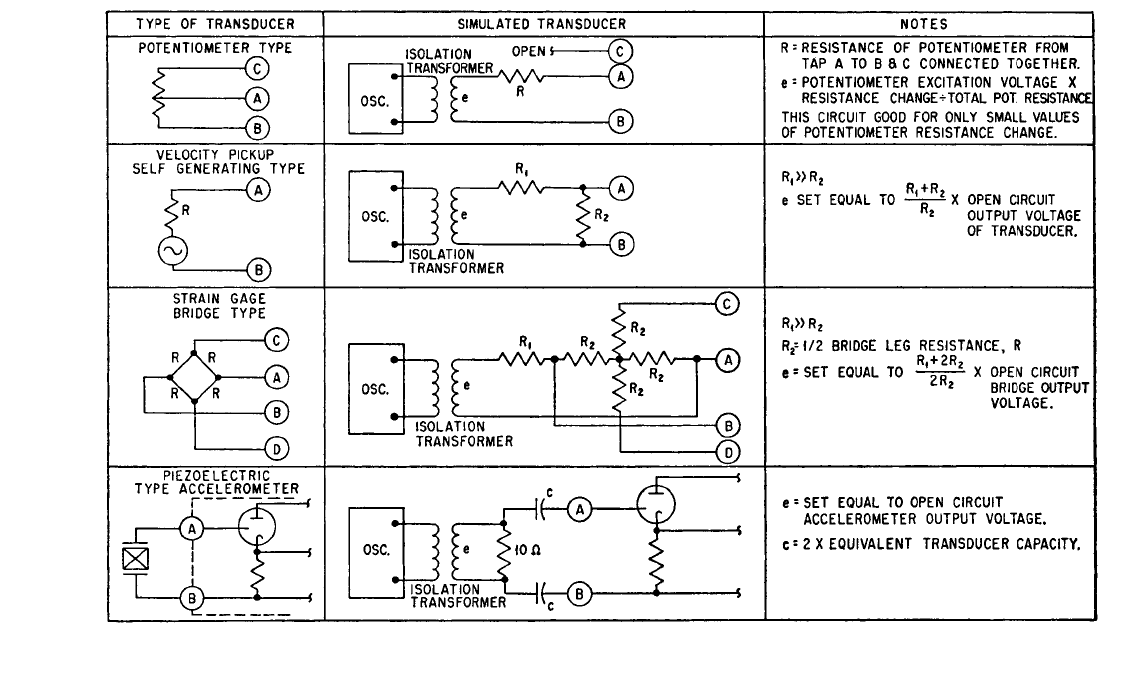
FIGURE 15.7 Electrical schematic diagrams of some common types of transducers and typical circuits used to
simulate them during field calibration.Terminals labeled A and B are the signal lead connections to which either
the transducer or the simulated transducer is connected.
15.17
8434_Harris_15_b.qxd 09/20/2001 11:10 AM Page 15.17
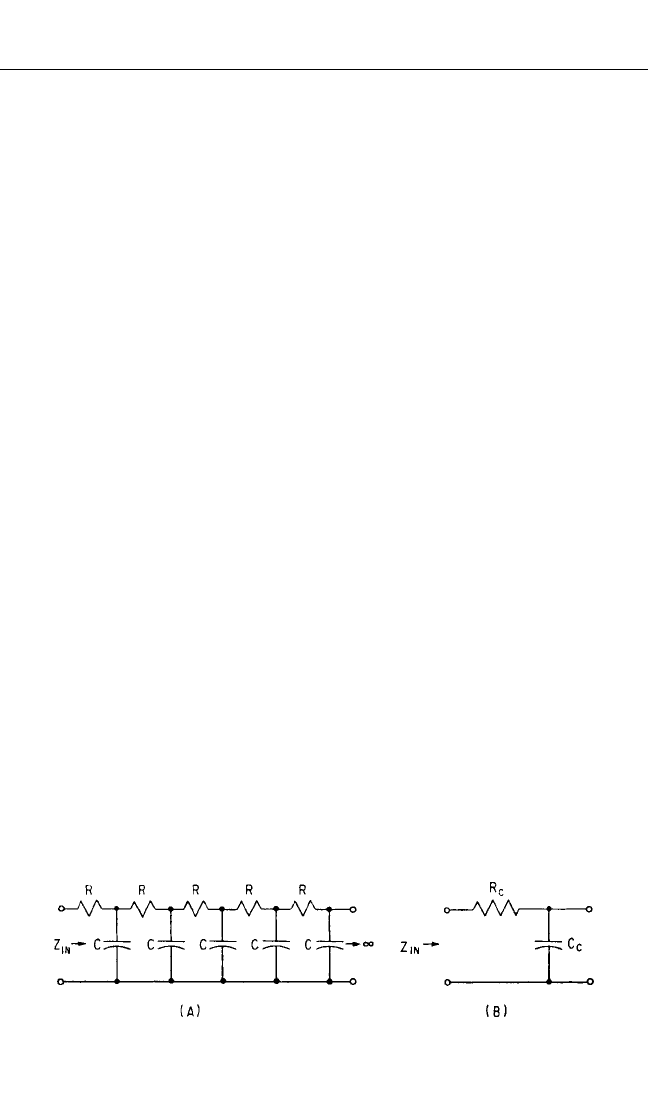
CABLE AND WIRING CONSIDERATIONS
The method of data transmission between a transducer and the electronic instru-
mentation which follows it depends on the complexity of the problem. In general,
cable is used for most problems, but the aerospace industry often relies on telemetry
for data transmission. Many types of cable are available. The choice of a suitable
cable depends primarily on the particular application, the transducer, the cable
length, whether the transducer is followed by a voltage amplifier or charge amplifier,
and environmental conditions. For example, cable jackets may be made of silicone
rubber having a useful temperature range from −100 to 500°F (−73 to 260°C), of
polyvinylchloride having a useful range from −65 to 175°F (−54 to 79°C), or of fused
Teflon having a useful range from −450 to 500°F (−268 to 260°C). Special-purpose
cables are available that can be used at much higher temperatures. In general, cable
should be as light and flexible as possible—consistent with other requirements. The
effect of the shunt capacitance of the cable following the transducer on the sensitiv-
ity of the transducer depends on the type of amplifier connected to the cable. If a
voltage amplifier is used, there is a reduction in sensitivity of the transducer, given
by Eq. (12.17). In contrast, when a charge amplifier is used, the effect of the shunt
capacitance of the cable in reducing the sensitivity of the transducer is negligible, as
shown in Eq. (13.2) (although the noise pickup in the high-impedance circuit
increases with cable length).
In the audio-frequency range, the series inductance L and the shunt leakage G
of short, good-quality cables are negligibly small in comparison with other param-
eters and may be neglected. Figure 15.8A shows the equivalent low-frequency
representation of a cable with distributed constants. For most purposes the simpler
lumped-constant configuration of Fig. 15.8B is a sufficiently accurate representa-
tion. The quantities R
c
and C
c
are the total resistance of the conductors and the
total capacitance between them, respectively. Values for a typical coaxial cable
having a Teflon dielectric are R
c
= 0.01 ohm/ft (0.03 ohm/m) and C
c
= 29 pF/ft
(88 pF/m).
The normal characteristic impedance of about 50 ohms for such cable has no sig-
nificance in most measurement problems, where cables usually are relatively short.
The open-circuit input impedance of the cable is almost exclusively capacitative.
When terminated, it takes on the impedance of the load, modified by the series and
shunt parameters.
In general, cables should be treated with the same care given transducers in
shock and vibration measurement systems. The following are based on recommen-
dations given in Ref. 1; they represent good engineering practice.
15.18 CHAPTER FIFTEEN
FIGURE 15.8 Successive approximations in the representation of a short, high-
quality transmission line at audio frequencies. (A) Distributed constant configuration
neglecting series inductance and shunt leakage. (B) Lumped-constant configuration.
8434_Harris_15_b.qxd 09/20/2001 11:10 AM Page 15.18
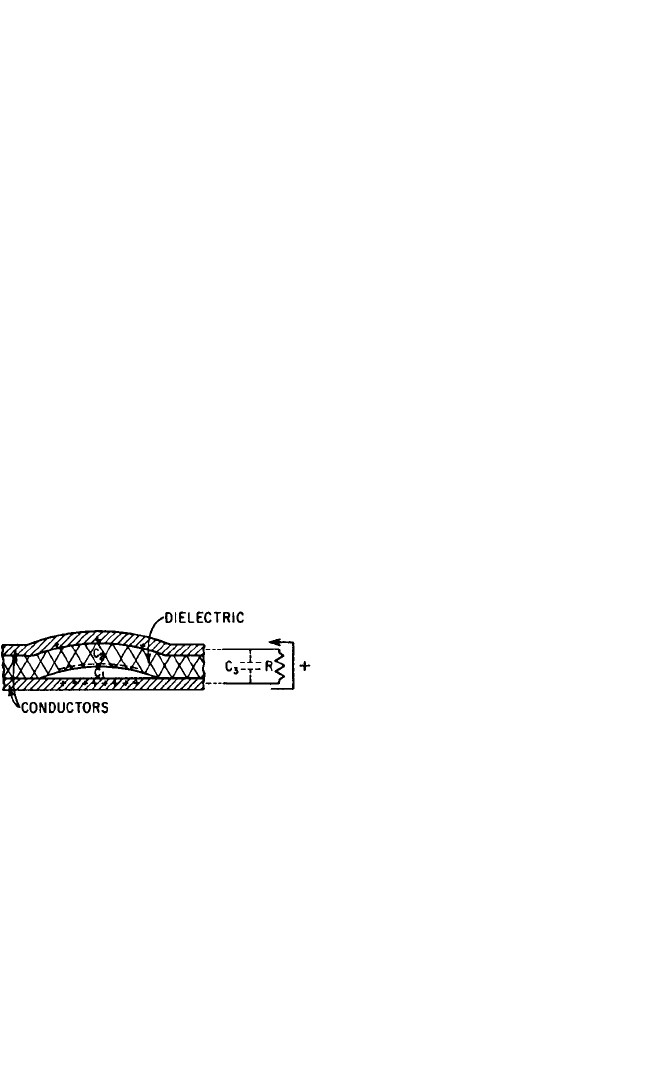
1. Attach a coaxial cable to a transducer by turning the connector nut onto the
threads of the transducer (not vice versa) to avoid damage to the pins.
2. Avoid cable whip by tying down the cable at a point near the transducer and at
regular intervals to avoid induced cable noise.
3. Screw the cable connection to the tightness specified by the manufacturer.
4. Loop the cable near the connector in a high-humidity environment, to allow con-
densation to drip off before reaching the connector.
5. Clean the cable connector before use (e.g., acetone or chlorothene) to remove
contamination as a result of handling; the contamination can create a low imped-
ance between the signal path and ground.
6. Check electrical continuity of cable conductors and shield if intermittent signals
are observed. Then, flex the cable—especially near the connector—and observe
if the signal is affected by flexing.
7. Select cables that are light and flexible enough to avoid loading the transducer
and/or the structure under test, or exerting a force on the transducer.
8. Avoid twisting the cable when it is connected to the transducer.
9. Move the cable back and forth to determine if such movement generates unac-
ceptable electrical noise; if so, tie the cable more securely or replace the cable.
CABLE NOISE GENERATION
When two dissimilar substances are rubbed together, they become oppositely
charged—a phenomenon known as triboelectricity, illustrated in Fig. 15.9. Thus a
charge may be generated when a cable is flexed, bent, struck, squeezed, or otherwise
distorted, for then such friction takes
place between the dielectric and the
outer shield or between the dielectric
and the center conductor.
3
A charge is
generated across the cable capacitance
so that a voltage appears across the ter-
mination of the cable.
Another mechanism by which noise
may be induced in the cable results from
the change in capacitance of the cable
when it is flexed. If the transducer pro-
duces a charge across the cable, the
change in capacitance results in a volt-
age change across the output of the cable, appearing as noise at the input of a volt-
age amplifier; it will not produce a similar change if a charge amplifier is used.
Suppose the dielectric surfaces within the cable are coated so that an electrical
leakage path is provided along the dielectric surface. Then if the cable shield is sep-
arated from the outer surface of the dielectric, the charges flow along the surface to
the nearest point of contact of the dielectric and shield; without this leakage path,
the charges would flow to the terminating impedance, where they would give rise to
a noise signal. Such coatings are provided in low-noise cables which are available
commercially. Cables of this type are capable of withstanding considerable abuse
before becoming noisy. Usually they are tested by the manufacturer continuously
along their lengths to assure meeting the low-noise characteristics. It is important in
fitting such a cable with a connector, or in splicing such a cable, that no conducting
MEASUREMENT TECHNIQUES 15.19
FIGURE 15.9 A section of cable during dis-
tortion, showing how separation of triboelectric
charge leads to the production of cable noise
across the termination resistance. (After T. T.
Perls.
3
)
8434_Harris_15_b.qxd 09/20/2001 11:10 AM Page 15.19

material be allowed to form a leakage path between the conductors. Carbon tetra-
chloride and xylene are satisfactory solvents and cleaning agents.
NOISE-SUPPRESSION TECHNIQUES
Under certain conditions of use and environment, spurious signals (noise) may be
induced in wiring and cables in a measurement system. Then there will be signals at
the termination of the system that were not present in the transducer output.
Electrical noise may be generated by motion of some parts of the wiring because
of variation in contact resistance in connectors, because of changes in geometry of
the wiring, or because of voltages induced by motion through, or changes in, the
electrostatic fields or magnetic fields which may be present. No cable should carry
wiring both for data transmission and for electrical power; all electrical power wiring
should be twisted pair. In general, such electrical noise will be reduced if the cable is
securely fastened to the structure at frequent intervals and if connectors are pro-
vided with mechanical locks and strain-relief loops in their cables. Precautions taken
to avoid interference usually include the use of shielding, cables which are only as
long as necessary, and proper grounding. Cable jackets must be selected that will not
deteriorate under the measurement environment. In addition, the use of a trans-
ducer containing an internal amplifier (described in Chap. 12) can provide advan-
tages in noise suppression.
Shielding. A change in the electric field or a change in the magnetic field around a
circuit or cable may induce a voltage within it and thus be a source of electrical noise.
Such electrical interference can be avoided by completely surrounding the circuit or
cable with a conductive surface which keeps the space within it free of external elec-
trostatic or magnetic fields.This is called shielding. Protection against changes in each
type of field is different.
Electrostatic Shields. Electrostatic shields provide a conducting surface for the
termination of electrostatic lines of flux. Stranded braid, mesh, and screens of good
electrical conductors such as copper or aluminum are good electrostatic shields.
Most shielded cables use copper braid as the outer conductor and electrostatic
shield. A good magnetic shield is also a good electrostatic shield, but the converse is
not true. For installations where cable lengths are especially long, where impedances
are high, or where noise interference is highly objectionable, double-shielded cable
is sometimes used. In this type of cable, a second shielding braid is woven over the
cable jacket, electrically insulating it from the inner shield; the inner braid furnishes
additional shielding against electrostatic fields which penetrate the first shield. The
shields should be connected to ground at one point only, as explained below under
Grounding; Avoiding Ground Loops.
Magnetic Shields. Magnetic shields are effective partly because of the short cir-
cuiting of magnetic lines of flux by low-reluctance paths and partly because of the
cancellation resulting from opposing fields set up by eddy currents. Accordingly,
they are made from high-permeability materials such as Permalloy, are as thick as
possible, and contain a minimum of joints, holes, etc.
Magnetic fields associated with current-carrying power lines, electronic equip-
ment, and power transformers are among the most troublesome sources of magnetic
interference in instrumentation setups—chiefly at the frequency of the power line
and its harmonics. Since these fields attenuate rapidly with distance from the source,
15.20 CHAPTER FIFTEEN
8434_Harris_15_b.qxd 09/20/2001 11:10 AM Page 15.20
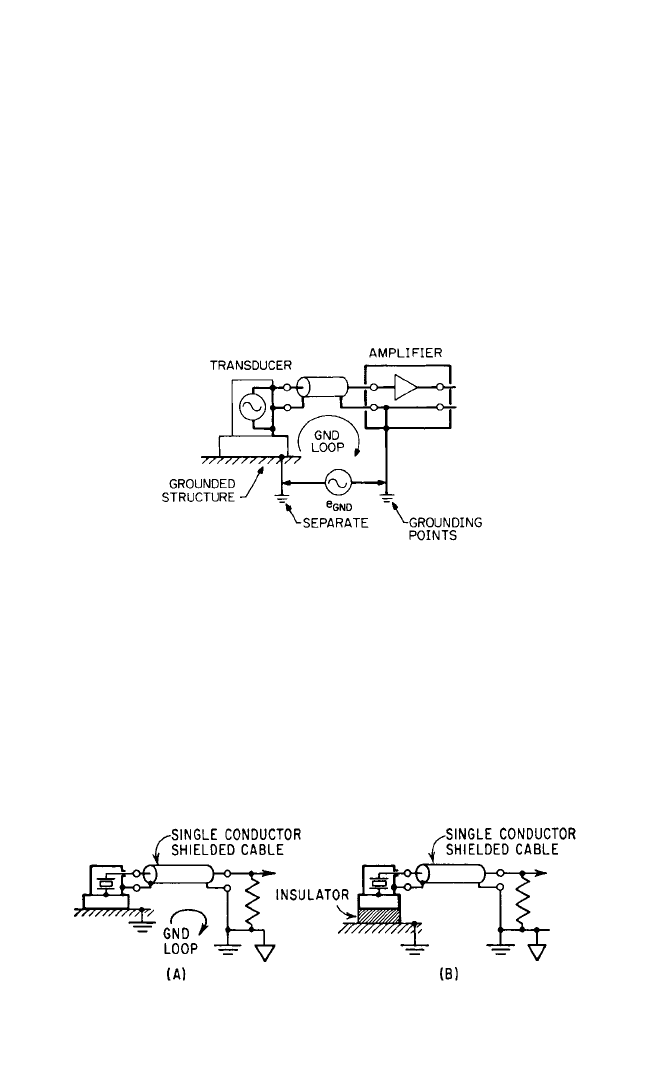
the most practical solution for this type of interference usually is to keep the signal
cables as far from the power source as possible.
Grounding; Avoiding Ground Loops. A circuit is said to be grounded when
one terminal of the circuit is connected to the “earth.” Grounding removes the
potential difference between that side of the circuit and earth, and the variable
stray capacitances which tend to induce voltages in “floating” (i.e., ungrounded)
systems. Water pipes make good ground connections because of their intimate con-
tact with the earth.
Ground loops are formed when a common connection in a system is grounded
at more than one point, as illustrated in Fig. 15.10, where the cable shield is
grounded at both ends. Since it is unlikely that the two grounds will be at a common
potential, their potential difference, e
gnd
, will be the source of circulating currents in
MEASUREMENT TECHNIQUES 15.21
FIGURE 15.11 (A) A ground loop formed when the “low” sides of both the
transducer and the amplifier are connected to their respective cases, which are
grounded. (B) The ground loop shown in (A) is broken by isolating the case of
the transducer from ground.
FIGURE 15.10 Ground loop in a system as a
result of grounding the cable shield at two points.
Then, the input signal e
1
is modulated by the poten-
tial difference e
gnd
which develops between these
two points.
the ground loop.Then a signal produced by the transducer will be modulated by the
potential e
gnd
, thereby introducing noise in the measurement system. Such a condi-
tion may occur when one end of a cable is connected to one side of the electrical
output of a transducer that has been grounded to the transducer’s housing and the
other end of the cable is connected to a voltage amplifier or signal conditioner
which is also grounded (usually to the case of the instrument). Then, a ground loop
will be formed. Such a condition must be avoided by grounding the circuit at only
8434_Harris_15_b.qxd 09/20/2001 11:10 AM Page 15.21

one point. Thus the circuit shown in Fig. 15.11A will result in noise because of the
ground loop, but by insulating the transducer as shown in Fig. 15.11B the ground
loop has been broken.
DATA SHEETS FOR LOGGING TEST
INFORMATION
When data are acquired in the field, measurement conditions may be far from ideal;
environmental conditions may be unfavorable, and the time available for measure-
ments may be extremely limited.Therefore it is good practice to prepare data sheets
that are relatively simple and that require a minimum amount of writing; for exam-
ple, use multiple-choice entries. The data sheets should include sufficient informa-
tion so that someone else, at a later time, could duplicate the measurement setup on
the basis of information supplied by the data sheets. If there are any anomalies that
occur during the test, they should be duly noted. In general, the following informa-
tion should be included:
Basic data concerning the test measurements:
●
Date, times, and duration of test.
●
Identification of test by test number.
●
Identification of equipment, machine, or device under test.
●
Conditions of operation during the measurement.
●
Any anomalies in operation and their times of occurrence.
●
Location of test, using diagram where appropriate.
●
Environmental conditions during test; note anomalies where appropriate.
●
Persons participating in the test.
Equipment, including transducers, cables, signal conditions, data recorders, telemeter:
●
Type.
●
Manufacturer, model number, and serial number.
●
Transducer sensitivity, exact location, orientation, and type of mounting.
●
Signal conditioner and amplifier gain and attenuator settings; note any changes in
these settings during the test.
●
Filter settings, if any.
●
Recorder speed, number of tracks, tape speed, gain settings; note any changes in
these settings during the test.
Calibration information:
●
Transducer calibration.
●
Overall system (end-to-end) calibration of system.
●
Phase of output signal relative to input signal.
●
Any changes in calibration between pretest and posttest conditions.
15.22 CHAPTER FIFTEEN
8434_Harris_15_b.qxd 09/20/2001 11:10 AM Page 15.22
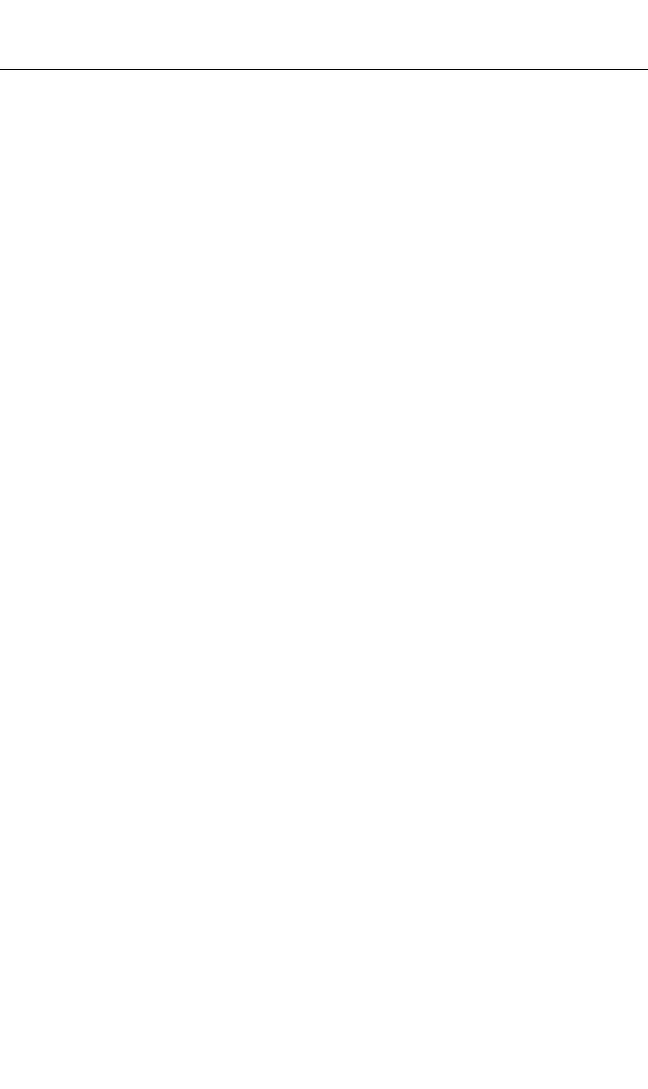
REFERENCES
1. Endevco Corp.: “A Guide for Accelerometer Installation,” TP 319, San Juan Capistrano,
Calif., 1999.
2. Himelblau, H., A. G. Piersol, J. H. Wise, and M. R. Grundrig (eds.): “Handbook for Dynamic
Data Acquisition and Analysis,” IEST Recommended Practice DTE012.1, Institute of Envi-
ronmental Sciences and Technology, Mt. Prospect, Ill., 1994.
3. Perls, T. A.: J. Appl. Phys., 23(6):674 (1952).
MEASUREMENT TECHNIQUES 15.23
8434_Harris_15_b.qxd 09/20/2001 11:10 AM Page 15.23
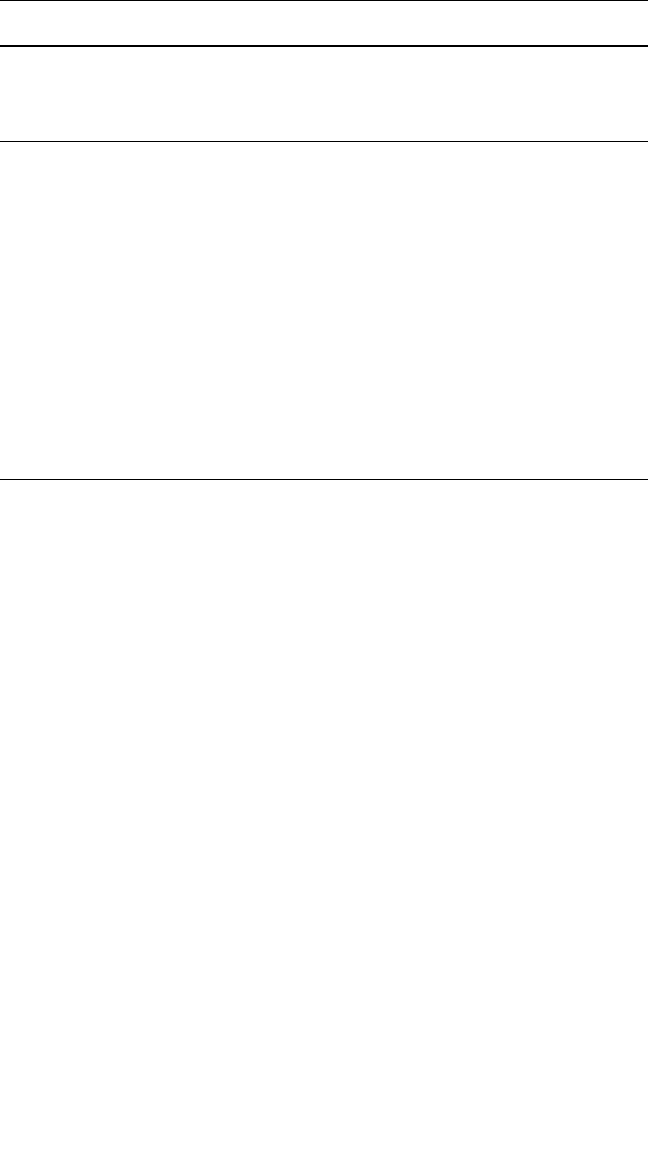
CHAPTER 16
CONDITION MONITORING
OF MACHINERY
Joëlle Courrech
Ronald L. Eshleman
INTRODUCTION
Condition monitoring of machinery is the measurement of various parameters
related to the mechanical condition of the machinery (such as vibration, bearing
temperature, oil pressure, oil debris, and performance), which makes it possible to
determine whether the machinery is in good or bad mechanical condition. If the
mechanical condition is bad, then condition monitoring makes it possible to deter-
mine the cause of the problem.
1,2
Condition monitoring is used in conjunction with predictive maintenance, i.e.,
maintenance of machinery based on an indication that a problem is about to occur.
In many plants predictive maintenance is replacing run-to-breakdown maintenance
and preventive maintenance (in which mechanical parts are replaced periodically at
fixed time intervals regardless of the machinery’s mechanical condition). Predictive
maintenance of machinery:
●
Avoids unexpected catastrophic breakdowns with expensive or dangerous conse-
quences.
●
Reduces the number of overhauls on machines to a minimum, thereby reducing
maintenance costs.
●
Eliminates unnecessary interventions with the consequent risk of introducing
faults on smoothly operating machines.
●
Allows spare parts to be ordered in time and thus eliminates costly inventories.
●
Reduces the intervention time, thereby minimizing production loss. Because the
fault to be repaired is known in advance, overhauls can be scheduled when most
convenient.
This chapter describes the use of vibration measurements for monitoring the
condition of machinery. Vibration is the parameter which can be used to predict
16.1
8434_Harris_16_b.qxd 09/20/2001 12:16 PM Page 16.1

the broadest range of faults in machinery most successfully. This description
includes:
●
Selection of an appropriate type of monitoring system (permanent or periodic)
●
Establishment of a condition monitoring program
●
Fault detection
●
Spectrum interpretation and fault diagnosis
●
Special analysis techniques
●
Trend analysis
●
The use of computers in condition monitoring programs.
TYPES OF CONDITION MONITORING SYSTEMS
Condition monitoring systems are of two types: periodic and permanent. In a peri-
odic monitoring system (also called an off-line condition monitoring system),
machinery vibration is measured (or recorded and later analyzed) at selected time
intervals in the field; then an analysis is made either in the field or in the laboratory.
Advanced analysis techniques usually are required for fault diagnosis and trend
analysis. Intermittent monitoring provides information at a very early stage about
incipient failure and usually is used where (1) very early warning of faults is
required, (2) advanced diagnostics are required, (3) measurements must be made at
many locations on a machine, and (4) machines are complex.
In a permanent monitoring system (also called an on-line condition monitoring
system), machinery vibration is measured continuously at selected points of the
machine and is constantly compared with acceptable levels of vibration.The princi-
pal function of a permanent condition monitoring system is to protect one or more
machines by providing a warning that the machine is operating improperly and/or
to shut the machine down when a preset safety limit is exceeded, thereby avoiding
catastrophic failure and destruction. The measurement system may be permanent
(as in parallel acquisition systems where one transducer and one measurement
chain are used for each measurement point), or it may be quasi-permanent (as in
multiplexed systems where one transducer is used for each measurement point but
the rest of the measurement chain is shared between a few points with a multiplex-
ing interval of a few seconds).
In a permanent monitoring system, transducers are mounted permanently at
each selected measurement point. For this reason, such a system can be very costly,
so it is usually used only in critical applications where: (1) no personnel are available
to perform measurements (offshore, remote pumping stations, etc.), (2) it is neces-
sary to stop the machine before a breakdown occurs in order to avoid a catastrophic
accident, (3) an instantaneous fault may occur that requires machine shutdown, and
(4) the environment (explosive, toxic, or high-temperature) does not permit the
human involvement required by intermittent measurements.
Before a permanent monitoring system is selected, preliminary measurements
should be made periodically over a period of time to become acquainted with the
vibration characteristics of the machine. This procedure will make it possible to
select the most appropriate vibration measurement parameter, frequency range, and
normal alarm and trip levels.
16.2 CHAPTER SIXTEEN
8434_Harris_16_b.qxd 09/20/2001 12:16 PM Page 16.2
